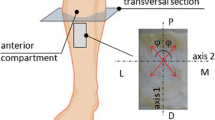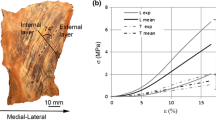Abstract
Ten dissections of inferior limbs and histological studies were performed to describe the structural conformation of the muscular fascia of the leg (crural fascia) and to propose a constitutive model to be adopted for the analysis of its biomechanical behaviour. The crural fascia had a mean thickness of 924 μm and was composed of three layers (mean thickness 277.6 μm) of parallel, collagen fibre bundles separated by a thin layer of loose connective tissue (mean thickness 43 μm). Only a few elastic fibres were highlighted. The disposition of the collagen fibres gives the crural fascia anisotropic characteristics. In addition, their crimped conformation is the cause of the non-linear elastic behaviour of the tissue. Both these aspects are included in the constitutive model. The constitutive modelling of the crural fascia represents a useful tool to rationally interpret the correlation between functional behaviour and structural conformation.






Similar content being viewed by others
References
Bermudez K, Knudson MM, Morabito D, Kessel O (1988) Fasciotomy, chronic venous insufficiency, and the calf muscle pump. Arch Surg 133:1356–1361
Bogduk N, Macintosh JE (1984) The applied anatomy of the thoracolumbar fascia. Spine 9:164–170
Fawcett DW (1994) Bloom and Fawcett: a textbook of histology, 12th edn. Chapman & Hall, New York
Flory PJ (1961) Thermodynamic relations for high elastic materials. Trans Faraday Soc 57:829–838
Gerlach UJ, Lierse W (1990) Functional construction of the superficial and deep fascia system of the lower limb in man. Acta Anat 139:11–25
Geneser F (1986) Textbook of histology. Munksgaard Lea & Febiger, Copenhagen
Gurtin ME (1981) An introduction to continuum mechanics. Academic, San Diego
Hammer WI (2007) Functional soft-tissue examination and treatment by manual methods, 3rd edn. Jones and Bartlett Publishers, Sudbury
Holzapfel GA, Gasser TC (2001) A viscoelastic model for fibre-reinforced composites at finite strains: continuum basis, computational aspects and applications. Comput Methods Appl Mech Eng 190:4379–4403
Langevin HM, Sherman KJ (2007) Pathophysiological model for chronic low back pain integrating connective tissue and nervous system mechanisms. Med Hypotheses 68:74–80
Marsden JE, Hughes TJR (1968) Mathematical foundations of elasticity. Prentice-Hall, Englewood Cliffs
Martini FH, Timmons MJ, Tallitsch RB (2003) Human anatomy, 4th edn. Prentice-Hall, New Jersey
Maurel W, Wu Y, Magnenat Thalmann N, Thalmann D (1997) Biomechanical models for soft tissue simulation. Springer, New York
Myers T (2001) Anatomy trains. Churchill Livingstone, Oxford
Natali AN, Pavan PG, Carniel EL, Dorow C (2004) Visco-elastic response of the periodontal ligament: an experimental-numerical analysis. Connect Tissue Res 45:222–230
Natali AN, Pavan PG, Carniel EL, Lucisano ME, Taglialavoro G (2005) Anisotropic elasto-damage constitutive model for the biomechanical analysis of tendons. Med Eng Phys 27:209–214
Natali AN, Carniel EL, Pavan PG, Sander FG, Dorow C, Geiger M (2008) A constitutive model for the analysis of the biomechanical response of the periodontal ligament. J Biomech Eng-T ASME 130(3):031004
Paoletti S (2002) Les Fascias: Rôle des tissus dans la mécanique humaine. Sully, Vannes
Rolf IP (1997) Rolfing. Mediterranee, Roma
Singh N, Sidawy AN, Bottoni CR, Antedomenico E, Gawley TS, Harada D, Gillespie DL, Uyehara CF, Cordts PR (2006) Physiological changes in venous hemodynamics associated with elective fasciotomy. Ann Vasc Surg 20:301–305
Spencer AJM (1984) Continuum theory of the mechanics of fibre-reinforced composites. Springer, New York
Standring S, Ellis H, Healy J, Johnson D, Williams A (2005) Gray’s anatomy, 39th edn. Churchill Livingstone, London
Stecco C, Porzionato A, Macchi V, Tiengo C, Parenti A, Aldegheri R, Delmas V, De Caro R (2006) Histological characteristics of the deep fascia of the upper limb. Ital J Anat Embryol 111:105–110
Stecco C, Gagey O, Macchi V, Porzionato A, De Caro R, Aldegheri R, Delmas V (2007) Tendinous muscular insertions onto the deep fascia of the upper limb First part: anatomical study. Morphologie 91:29–37
Stecco C, Gagey O, Belloni A, Pozzuoli A, Porzionato A, Macchi V, Aldegheri R, De Caro R, Delmas V (2007) Anatomy of the deep fascia of the upper limb Second part: study of innervation. Morphologie 91:38–43
Stecco C, Porzionato A, Macchi V, Stecco A, Vigato E, Parenti A, Delmas V, Aldegheri R, De Caro R (2008) The expansions of the pectoral girdle muscles onto the brachial fascia: morphological aspects and spatial disposition. Cells Tissues Organs 188:320–329
Stecco L (2004) Fascial manipulation for musculoskeletal pain. Piccin, Padova
Tiller WA (1987) What do electrodermal diagnostic acupuncture instruments really measure. Am J Acupunct 15:18–23
Vidal BC, Mello ML (2008) Optical anisotropy of collagen fibers of rat calcaneal tendons: an approach to spatially resolved supramolecular organization. Acta Histochem: 07.005
Yahia LH, Pigeon P, DesRosiers EA (1993) Viscoelastic properties of the human lumbodorsal fascia. J Biomed Eng 15:425–429
Weiss JA, Maker BN, Govindjee S (1996) Finite element implementation of incompressible, transversely isotropic hyperelasticity. Comput Methods Appl Mech Eng 135:107–128
Author information
Authors and Affiliations
Corresponding author
Rights and permissions
About this article
Cite this article
Stecco, C., Pavan, P.G., Porzionato, A. et al. Mechanics of crural fascia: from anatomy to constitutive modelling. Surg Radiol Anat 31, 523–529 (2009). https://doi.org/10.1007/s00276-009-0474-2
Received:
Accepted:
Published:
Issue Date:
DOI: https://doi.org/10.1007/s00276-009-0474-2




